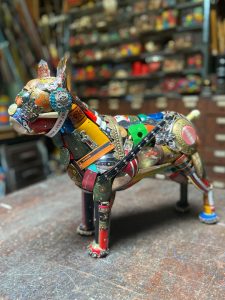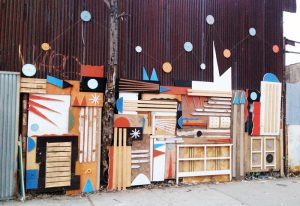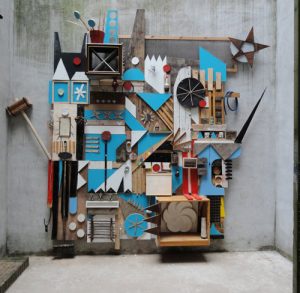Picture this: Recycled materials, paper, plastic, and even hair, shaped into a brilliant piece of art in the middle of an office. This incredible vision was created by WRAP, the Waste Reduction Art Project, to stop the cycle of building waste. Founder Yana Good Nigen established the project in February 2020, along with several talented artists, to help the world live more sustainably and positively impact the environment. BCCI Construction’s Mallory Wall is a member of WRAP’s advisory board and joined Nigen to discuss how WRAP makes a difference.
How did you get involved in WRAP?
Nigen: During my career in human resources, I saw disconnects between the departments that take on corporate social responsibility versus the execution level of HR and employee engagement. Coming from a background in both HR and marketing, I was able to navigate that space and bring the idea of recycling as fun and creative to the corporate culture. My thought process began with making recycling a priority for leaders and giving them the tools and know-how to implement that process into their organizations.

Wall: I learned about WRAP through a client, and she introduced Yana to me, virtually. BCCI is very big on sustainability. In construction, we tend to produce a considerable amount of waste and BCCI’s involvement with WRAP helps us understand how we can make a difference and a positive impact on our environment. Our effort is about getting the message out there and understanding waste and how waste can make art. It’s important to socialize these things internally and externally, utilizing some of our existing relationships with architects, designers, and clients. We want to continue to message anything that allows us to think outside of the box. This is one of many little things that can make a difference…and the artwork is beautiful, fun, and creative.
Nigen: I can’t thank Mallory enough for being such an advocate for WRAP. I absolutely appreciate everything Mallory does as a member of the board.
How do you find artists?
Nigen: I started calling and networking with artists I knew were great matches for WRAP. Everyone thought it was a great idea to bring in artists to get corporate clients excited about saving the planet in a fun, creative way. Our artists have such rich stories about the way they collect their art. One walks around his neighborhood in Amsterdam and collects pieces, creates sculptures, and places them throughout the community. Another creates incredible tapestries out of hair. We’re currently working on adding new artists to create that global footprint.
What does WRAP offer to companies?
Nigen: WRAP began with the idea of going into corporate offices and doing work within multiple locations. Unfortunately, COVID-19 has set us back from physically going into the offices and building art pieces. Our solution was to create virtual workshops, which we’re continuing. In fact, we hosted a virtual workshop with Zillow’s employees that was very successful. Ten thousand employees of the company participated, and they were able to create recycled art pieces with guidance from our WRAP artists.
But we began with several different services, such as office augmentations in terms of furniture and design. For example, we spoke to a client with several cabinets and other furniture that they were discarding. They asked our artists if they could make something fun and creative out of these objects. From there, our artists planned and designed those specific pieces for said office. Thus, the history of how the office grew and evolved is captured in that art piece and the discarded furniture did not go into landfills.

We use artwork for both corporate social responsibility and environmental, social, and governance (ESG) reporting. WRAP artists can bring in recycled art to make the reports come alive and showcase a report’s graphics. We also have employee engagement events, host corporate mural festivals, and can create company gifts made by WRAP artists.
WRAP also measures impact. We partnered with Empower, a global company based in Europe, that applies the blockchain idea to track the collection and assemblage of art pieces. For example, we host an employee engagement program at a company, and every employee contributes a portion of recycled material. Later, all these pieces are sent to the artists, and we track the entire history. It’s completely anonymous and by department. Not only is it accurate and visual, but the companies always enjoy it.
What do you enjoy most about working with WRAP?

Wall: I like the idea that we’re a team. We’re all learning to explore creative ways in which we can transform waste into something beautiful and make a positive impact. There is so much opportunity with our network of relationships, from architects and designers to owners and clients, to think outside the box and create installations for companies and public spaces that can be appreciated.
Nigen: I am so proud of the WRAP team. They’ve persevered through COVID-19, helped keep WRAP going, and continued with the virtual workshop. I’m also proud of our WRAP artists who continue to build and create art in such difficult conditions. However, we’re ready to bring in our artists to collaborate with companies and host additional mural festivals.
What’s next for WRAP?
Nigen: Our immediate plan is to get more artists on board. We’re constantly adding new artists and getting in front of as many clients as we can to bring this idea to corporate culture. We’re looking at growing an educational component where we would provide services to low-income communities, whether schools or senior living facilities, on how to create recycled art. We also value our relationship with BCCI and look forward to working more together!
The pandemic affected construction projects across the globe—but maybe nowhere more significantly than the San Francisco Bay Area. In the US, the Bay Area had some of the most stringent restrictions, which impacted schedules, materials, and even clients’ design decisions.
That was certainly the case for Autodesk’s new downtown San Francisco office, built by BCCI Construction. The 117,000 sf project spans four floors with a three-story staircase that unites the open office spaces, meeting areas, break rooms, and special amenities across the workplace.
Two months into construction, the pandemic put the project on hold for roughly seven weeks. The Autodesk team took the opportunity to survey their employees, make adjustments to the design, and implement COVID-safe features such as plexiglass desk shields, contactless fixtures and devices, anti-bacterial film on high-touch devices, digital “community board” monitors to remind employees of protocols, and more. They also made the decision to lower the overall office capacity by 30 percent to support proper physical distancing in desk and collaboration areas.
“Some of those adjustments were minor, but some, like new furniture layouts, did impact things like electrical configurations,” says BCCI project manager Max Heath. “We had to pull together as a project team to work through decisions virtually while the jobsite was shut down.”
BCCI had conducted full 3D scans of the existing space before demolition, which helped not only remove potential conflicts and challenges in the initial phases of the work but also better manage those very kinds of adjustments. The team also used Autodesk’s best-inbreed, cloud-based project management system, BIM 360, for data management and collaboration, meaning all of the RFIs, submittals, construction documents, schedules, drawings, and other records were available to the project team during the shutdown and after for the full project duration.
“Tenant improvement projects rarely get that level of laser scanning since project schedules tend to be tight. We knew those scans would make the MEP coordination process more efficient, and our overall approach to the project with virtual design and construction tools proved critical to helping us get back and up and running effectively.”
Max Heath, Project Manager, BCCI Construction
Pulling together to work through the continued COVID-related challenges—from staggered trade schedules to manufacturing delays—the project team was able to bring Autodesk’s collaborative vision to life. In addition to the pandemic-related adjustments, the new office includes a number of unique amenities for employees, from a music studio and game room to a gym and shower area.



Autodesk was also mindful of sustainability, incorporating electric scooter charging stations, compost options, and an abundance of plants and other natural elements. In the four corners of every floor, custom wooden “trees,” rise up from the floor and parallel the ceiling to provide an element of biophilia while light fixtures, suspended from the ceiling, hang between the tree “limbs.” All of these special features aim to reflect the concepts employees noted they valued most during the survey process.
“The pandemic will likely have a lasting impact on how offices will be designed and operated in the future. Autodesk saw the development of their offices at 300 Mission as an opportunity to explore these new possibilities and rethink its design to support the health and wellbeing of its employees for years to come.”
Wendy Peterson, Project Executive, BCCI Construction